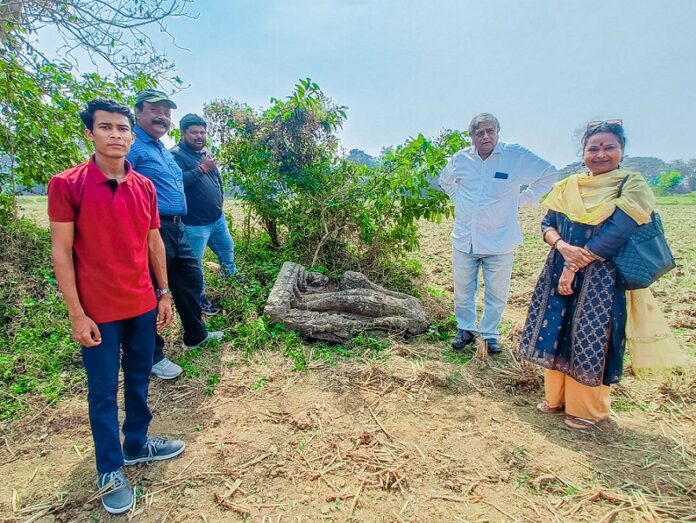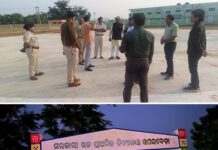
By Our Correspondent
BHUBANESWAR: A team from the Cuttack Chapter of Indian National Trust For Art & Cultural Heritage (INTACH) has discovered the remnants of a Buddhist site near Ganeswarapur village in Tangi Tehsil of Cuttack district. The site, with scattered Buddhist archaeological remains, was found near a small mound inside a rice field at the far end of the village. The five member team of Dr. Biswajit Mohanty, Ritu Pattanaik, Deepak Kumar Nayak, Suman Prakash Swain and Anil Dhir visited the find spot to conduct a preliminary survey and document the archaeological remains found at the site. The site is just 150 metres away from the Birupa embankment.
According to Deepak Kumar Nayak, Co-convenor of INTACH’s Cuttack Chapter, the present and ancient floodplains of the Birupa River are dotted with numerous Buddhist sites on both the banks. The discovery of a large headless Abalokiteswar image, nearly six feet in height which is lying on the ground near a small wooded grassy mound is an important find. Although the head is missing, the iconography closely matches with the Abalokiteswar images found in nearby Buddhist sites of Ratnagiri, Udayagiri and Lalitagiri. The excavated Buddhist Stupa in the nearby Rameswar village is placed across the river, where the images are now being worshiped by the villagers as Hanumancheswara Mahadev.
According to Anil Dhir, this find further indicates the fact that that Buddhism flourished in the region in ancient times. The exact period can only be ascertained after a systematic archaeological excavation, however, comparing the broken Abalokiteswar image with such images found at other places it can be approximately assigned to a period prior to the 9th Century CE.
Dr. Biswajit Mohanty is of the opinion that the existence of a Buddhist Stupa or temple, which had the large images was buried under the silt due to the frequent flooding of the Birupa. The disfigured images lying at the site and at a small shrine made a few metres away are also indicative the destruction by iconoclastic invaders during the Afghan-Moghul period. Local lore has it that the other two temples in the village i.e. Panchupandava Temple and Tareswara Temple too were demolished by Kalapahada’s barbaric invasion in the 16th Century CE.
The remains of a base of a temple and many odd shaped kiln baked bricks suggest that either s temple or a stupa are buried in the mound. The team also discovered a large number of broken potsherds which included both Red and Blackware. Gopal Behera, the Convener of the Cuttack Chapter is writing to the ASI, the State Archaeology Department and the Culture Directorate to send experts to the spot for further detailed surveys.


























